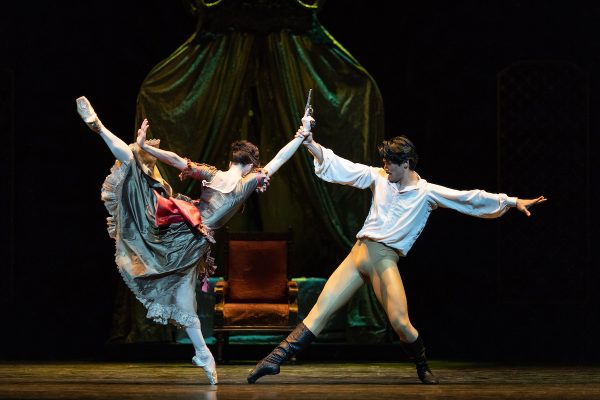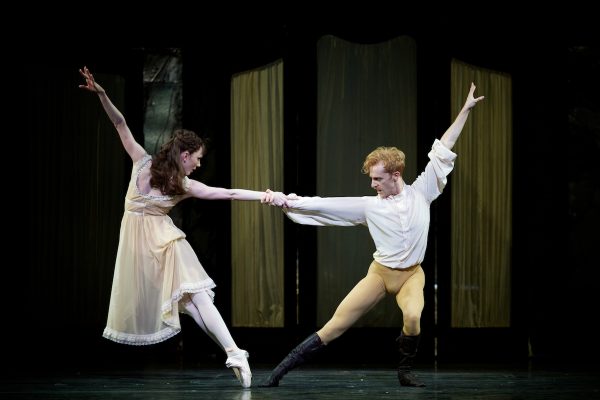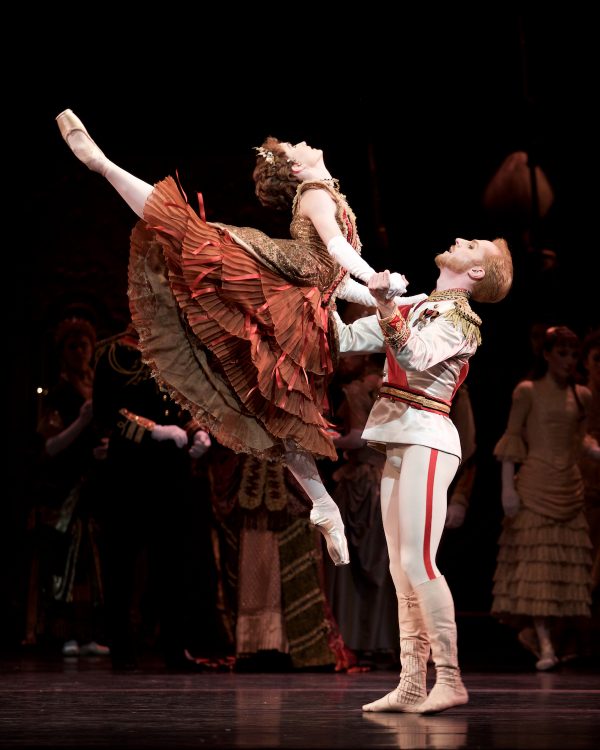An opulent, decadent court filled with political intrigue and hypocrisy, a syphilitic, drug and sex addicted crown prince with a death obsession who meets his match in a teenager. Could be HBO’s nominee to succeed Game of Thrones, possibly PBS fodder for the next The Crown, and certainly an unlikely plot for a full-length ballet, but it’s the last; choreographer Kenneth MacMillan’s Mayerling. The full-length ballet is one of two calling cards as Britain’s Royal Ballet visits after a 25 year absence.
Best known perhaps for his celebrated Romeo and Juliet, MacMillan was a master at translating aristocratic corruption and star-crossed passion into riveting ballets. Mayerling is definitely one of his darkest and most challenging, particularly for the male lead, the Hapsburg Crown Prince Rudolf, who has seven major pas de deux, almost never leaves the stage, and despite his abhorrent and predatory behavior, draws sympathy for this tormented soul.
The ballet’s plot is drawn from real events. Rudolf’s father emperor Franz Joseph I and mother Queen Elisabeth of Bavaria had no emotional relationship with their only son and the heir apparent to the throne of the Austro-Hungarian Empire. Syphilitic, drug addicted and sexually prolific, Rudolf ‘s final affair was with 17-year old Mary Vetsera. In 1889, both were found dead at his hunting lodge Mayerling.

In the ballet at his wedding, Rudolf openly tries to seduce the bride’s sister, then terrorizes his new wife on their wedding night, forces her to accompany him to a brothel, and having established Rudolf is not prince charming, the action shifts to young Baroness Mary Vetsera. One of Rudolf’s former mistresses arranges for 17-year old Mary to become 30-year old Rudolf’s next mistress. A year later the both are found dead at Mayerling in what is generally considered a murder suicide. The ballet opens and closes with the same scene, but only at the end is it clear these are Mary’s relatives who propped her up as if alive and removed her from Mayerling in a cover up.
Although not part of the ballet, part of the significance of the events comes 20 years later. With the death of crown prince Rudolf in 1889, his cousin becomes the next heir apparent to the throne. The cousin is Archduke Franz Ferdinand, whose assassination in 1914 was the first domino to fall in the chain reaction that became World War I. It’s worth a mention since American knowledge of European aristocracy is usually limited to the travails of British royalty despite the 1968 film with Omar Sharif and Catherine Deneuve as Rudolf and Mary.
The director’s notes on casting
The Royal Ballet arrives this week from Japan where it has been on tour. The director Kevin O’Hare and principal dancer Lauren Cuthbertson juggled the time difference in Japan to talk about Mayerling as well as the second week’s more contemporary offering, a collaboration of resident choreographer Wayne McGregor and composer Thomas Adès.
Q: Los Angeles is seeing three different dancers as Rudolf and three different dancers as Mary. Except for Natalia Osipova who has performed here, Los Angeles audiences are less familiar with current Royal Ballet stars. MacMillan was known for liking dancers who brought individuality to their interpretations. Would you talk a bit about Mayerling and the individual interpretation each of three pairings brings to Rudolf and Mary?
O’HARE: The ballet is a very big story, but it does come down to these two people. The part of Rudolf especially is the Mount Everest of male dancing. Hard as it is, the guys relish it.
Q: Opening night is Ryoichi Hirano and Natalia Ospiova?
O’Hare: Ryoichi is turning into one of the company’s great dancing actors. He’s a big man and brings a large physical presence and great force to Rudolf. Ryoichi danced many of the other roles so he had the ballet’s history in his DNA before making his debut as Rudolf last fall. He is such a massive presence that it is powerful to see this big physical presence disintegrate with all his psychological pressures. Natalia is more vulnerable and weak. You can see from the beginning that she is totally obsessed with him and feels where this is going from the minute she puts eyes on him.
Q: Saturday night is Matthew Ball and Sarah Lamb?
O’Hare: Matthew conveys a fragile young man who has been totally manipulated. You see his vulnerability. Sarah’s Mary is an innocent, although sort of calculating and sort of knows what she wants to do. She totally wants to be involved and wants to be with Rudolf, but at first doesn’t realize what’s to come. When she does, she completely goes with it.
Q: Sunday matinee is Thiago Soares and Lauren Cuthbertson?
O’Hare: I think that with those two, it’s a meeting of two equals. Thiago has danced the most of any of these leads, several times over the various revivals. Thiago’s Rudolfo is someone who can’t find a way out of the situation until he meets a person who is absolutely his equal. Lauren meets him head on at every turn.

There’s something about Mary
Cuthbertson also took time before a day packed with the gym and a swim, before boarding a bus to the Tokyo theater for class, rehearsal and performing. She first learned the role when she was 18, the same age as when Mary Vetsera died. Cuthbertson talked about her research into Mary and her involvement with Rudolf and the Habsburg court.
Q: Tell me about Mary as you have come to know her.
Cuthbertson: There’s a lot to tell. As a character, she’s a baroness, sort of a title without much more, but it was a title. Her mother was a social climber who wanted Mary to meet the right people and tried to establish her in society. Mary was always attracted to the crown prince. In my research, I found out that every year, postcards with pictures of the royal family and individuals in the royal family would be issued and Mary would collect his. For Mary, the postcards of Rudolf were like the rock star poster on my wall as a teen. So Mary was already fixated on him before they actually met. When they first met, she was very young and did not catch his eye, but when she was a bit older I think she made it happen. What makes the ballet and their relationship so magnetic is that whatever dark and twisted place he was in, she was able to meet him and more.
There is a scene in the second act where Mary sits with a portrait of Rudolf. And I love that moment because it ties into my research and MacMillan’s ballet by conveying as she stares at that portrait that she now is ready to meet Rudolf in an adult manner. It shows why I think hers was not an innocent attraction.
I used to think while she was not an innocent, she was an innocent part of his story. Now I feel that she was driving events, not in a malicious way, but she was driving the story and was very much a part of the end result. I think this insight gives Mary more strength and makes her more of an equal in what happens.
The way I like to play her is that she was his drug and a stronger narcotic than any he was taking. He already had a drug problem when they met. He had syphilis from the whorehouses which had been treated with arsenic and from there he developed his drug addiction. He already had this relationship with drugs before Mary and the way I see Mary is she was more toxic to him than the drugs. They have this incredibly dark relationship together, but it fueled something between them. Possibly the extremes they they pursued together was a fantasy until the reality entered and their relationship ended in death.
Back where it began in the U.S.
Mayerling has a history in LA where the ballet had its U.S. premiere the year following its 1978 Royal Ballet premiere. Reviewers from New York and the LA Times found the ballet raw, erotic and shocking, but praised the passionate dancing. When the ballet had its New York premiere in 1983, the critics were more accepting of the ballet’s ferocious excesses. When the Royal Ballet last brought it to LA in the 1990s, the reviews suggest the goalposts had moved on taste and acceptable display. The ballet was considered well within what television and movies had made acceptable.

Bringing in the LA Phil for Week 2
The second week of the visit takes a contemporary turn, a collaboration between the Royal Ballet’s resident choreographer Wayne McGregor and composer Thomas Adès with the composer conducting the L.A. Phil for three McGregor ballets, all with Adès’ music. Royal Ballet dancers will dance the world premiere of McGregor’s Inferno, a rare instance of the company premiering something outside of London’s Covent Garden Opera House. McGregor’s own contemporary company will dance a second premiere. In the third piece, McGregor’s troupe will be joined by Royal Ballet’s Sarah Lamb and Cuthbertson in Outlier, originally set on New York City Ballet.
Music Center, Dorothy Chandler Pavilion, 135 N. Grand Ave., downtown; Mayerling: Fri.-Sat., July 5-6, 7:30 p.m., Sun., July 7, 2 p.m., Adès & McGregor: Fri.-Sat., July 12-13, 7:30 p.m.,$38-$138. https://www.musiccenter.org/.
